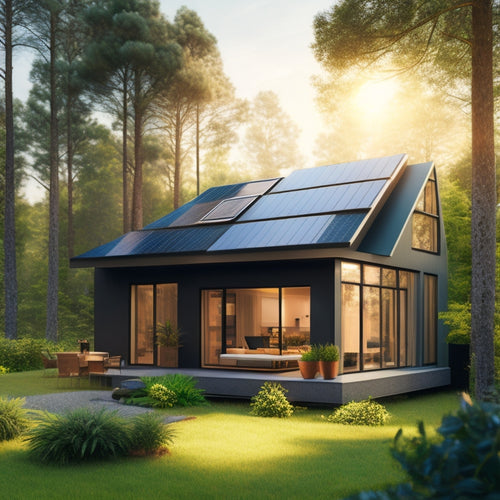
How to Install a Solar and Battery Home System
Share
You'll need to calculate your total energy consumption by listing appliances, their wattage, and daily usage hours to determine your daily energy needs in watt-hours. Then, choose the right equipment, including solar panels and a battery, considering factors like efficiency, durability, and cost. Prepare your roof by evaluating its condition, checking for obstructions, and confirming it can support the solar panel weight. Install the solar panels properly, connecting them to the battery system, and perform final testing and inspection to guarantee a safe and efficient system. As you traverse these steps, you'll uncover the complexities of a successful solar and battery home system installation.
Key Takeaways
- Assess your home's energy needs by calculating total energy consumption based on household appliances and their daily usage hours.
- Choose the right equipment, including solar panels, batteries, and inverters, based on efficiency, durability, and cost, and ensure they match your energy needs.
- Prepare your home's roof by assessing its condition, ensuring structural integrity, and conducting a shading analysis to optimize solar panel installation.
- Install solar panels properly, following manufacturer instructions, and connect the battery system, ensuring secure electrical connections and proper integration.
- Perform final testing and inspection to verify safety protocols, assess energy generation and storage capabilities, and confirm monitoring system accuracy.
Assessing Your Energy Needs
To determine the size of your solar and battery home system, you need to assess your energy needs accurately. This involves calculating your total energy consumption, which depends on the type and number of household appliances you use.
Start by making a list of all your appliances, including lights, refrigerators, air conditioners, and electronics.
Next, determine the wattage of each appliance and how many hours you use it daily. You can find the wattage on the appliance's label or in its manual. Multiply the wattage by the number of hours used to get the total daily energy consumption in watt-hours (Wh).
Add up the energy consumption of all appliances to get your total daily energy needs.
You may also want to take into account your energy usage patterns, such as peak hours and seasonal variations. This will help you determine the required capacity of your solar and battery system.
Accurate energy needs assessment is essential to guarantee your system can meet your power requirements efficiently and effectively.
Choosing the Right Equipment
Several key components make up a solar and battery home system, and selecting the right equipment is essential to assure a reliable and efficient power supply.
You'll need to choose the best solar panel types for your system, considering factors like efficiency, durability, and cost. Monocrystalline and polycrystalline panels are popular options, but you may also consider thin-film or bifacial panels depending on your specific needs.
When it comes to batteries, you'll need to determine the required capacity to meet your energy demands. Battery capacity is typically measured in kilowatt-hours (kWh), and you'll want to guarantee you have enough storage to power your home during the night or on cloudy days.
A deeper understanding of your energy usage patterns will help you size your battery bank correctly.
You'll also need to select an inverter that can handle the power output of your solar panels and charge your batteries efficiently. Additionally, consider a charge controller that can regulate the flow of energy between your panels and batteries.
Preparing Your Home's Roof
With your equipment selected, it's time to focus on preparing your home's roof to accommodate the solar panel installation. Assess your roof's condition to verify it's suitable for solar panels.
Check for damaged, rotten, or missing shingles, and repair or replace them as needed. Perform a shading analysis to identify potential obstructions, such as trees or nearby buildings, that could affect energy production.
Determine your roof's orientation, as a south-facing roof receives the most sunlight. Confirm your roof's structural integrity can support the weight of the solar panels. You may need to consult with a structural engineer or roofing expert if you're unsure.
Conduct a thorough inspection to identify any potential issues that could impact the installation or performance of your solar panel system.
Check local building codes and regulations to verify compliance. Make any necessary repairs or upgrades before moving forward with the installation.
Installing Solar Panels Properly
Frequently, a successful solar panel installation hinges on careful planning and execution. When you're ready to install your solar panels, make certain you've got the right orientation.
Solar panel orientation is vital, as it directly affects energy production. You'll want to angle your panels to maximize energy output, considering your location's latitude and the time of year. Typically, a tilt between 30-40 degrees is ideal.
Next, consider roof shading. Even partial shading can greatly decrease energy production. You'll need to assess your roof's shading patterns, taking note of trees, buildings, or other obstructions that could cast shadows on your panels. You may need to trim trees or install panels in a way that minimizes shading.
When installing the panels, verify they're securely fastened to your roof to withstand wind and weather. Follow the manufacturer's instructions for installation, and consider hiring a professional if you're not comfortable with the process.
Proper installation will guarantee your solar panels operate at peak efficiency, providing you with reliable, clean energy for years to come.
Connecting the Battery System
Once you've successfully installed your solar panels, it's time to connect the battery system, which stores excess energy generated by your solar panels for later use. This vital step guarantees you can employ the energy your solar panels produce when the sun isn't shining.
Start by connecting the battery bank to the charge controller, making sure to follow the manufacturer's instructions. Confirm the battery management system (BMS) is properly configured to monitor and control the charging and discharging of your batteries.
Next, integrate the battery system with your solar panel array, connecting the charge controller to the solar panels. This integration enables the system to harvest excess energy and store it in the batteries for later use.
Pay attention to the system's electrical connections, ensuring they're secure and meet the manufacturer's specifications. A well-integrated system is essential for efficient energy harvesting and storage.
Final Testing and Inspection
Your newly connected solar and battery home system is nearing completion, but before you start utilizing the power of the sun, it's essential to perform a thorough final testing and inspection. This step guarantees that your system operates safely and efficiently, meeting your energy needs.
During the testing process, you'll verify that all safety protocols are in place, including electrical connections, grounding, and surge protection.
Perform a performance evaluation to assess the system's ability to generate and store energy. Check the solar panels' output, battery state of charge, and inverter efficiency. Verify that the system can seamlessly shift between grid-tied and off-grid modes.
Confirm that the monitoring system is accurately tracking energy production and consumption. Conduct a series of tests to simulate various scenarios, such as grid outages or high energy demand. By doing so, you'll identify and address any potential issues before they become major problems.
A successful final testing and inspection will give you confidence in your solar and battery home system, allowing you to enjoy the benefits of renewable energy with peace of mind.
Frequently Asked Questions
Can I Install a Solar System on a Rented Property?
You're like a bird wanting to take flight with solar power, but your rental property has you grounded. Check your lease agreements, consider solar leasing, and investigate renter options like portable solar - they might just give you wings.
Are There Any Government Incentives for Home Solar Systems?
You'll be happy to know that you're eligible for federal tax credits, which cover up to 26% of your solar system's cost, and state rebates, which vary, but can add thousands more to your savings, making your investment more profitable.
Can I Use My Solar System During a Grid Outage?
You're not just a slave to the grid! With a solar system, you can capture the power of the sun even during outages, thanks to off-grid capabilities and battery storage that lets you shine bright, literally, when the grid goes dark.
How Long Does a Typical Solar System Installation Take?
You're likely wondering how long the installation process will take; typically, a solar system installation timeline spans 2-5 days for a standard residential project, with the project duration varying depending on system complexity and site conditions.
Will Solar Panels Affect My Roof's Warranty?
You're right to worry that solar panels might void your roof's warranty; however, most manufacturers now provide warranties that accommodate solar panel installation, and some even offer specialized roof warranty considerations for solar-equipped homes.
Related Posts
-

Master Advanced Solar Panel Design Online for Free
You can master advanced solar panel design online for free by leveraging specialized courses and training platforms, ...
-

Top 10 Tips for Buying Car Accessories Online
When purchasing car accessories online, you should take proactive steps to avoid low-quality or incompatible products...
-

Reduce Solar Panel Cost for Your Small Home
By evaluating your energy needs, choosing the right installer, and selecting cost-effective solar panel options, you ...


